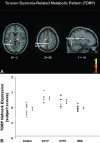Neuroimaging and therapeutics in movement disorders
- PMID: 15897956
- PMCID: PMC1064997
- DOI: 10.1602/neurorx.2.2.361
Neuroimaging and therapeutics in movement disorders
Abstract
In this review, we discuss the role of neuroimaging in assessing treatment options for movement disorders, particularly Parkinson's disease (PD). Imaging methods to assess dopaminergic function have recently been applied in trials of potential neuroprotective agents. Other imaging methods using regional metabolism and/or cerebral perfusion have been recently introduced to quantify the modulation of network activity as an objective marker of the treatment response. Both imaging strategies have provided novel insights into the mechanisms underlying a variety of pharmacological and stereotaxic surgical treatment strategies for PD and other movement disorders.
Figures





References
-
- Ravina B, Eidelberg D, Ahlskog JE, Albin R, Brooks DJ, Carbon M, et al. The role of radiotracer imaging in Parkinson's disease. Neurology 64: 208–215, 2005. - PubMed
-
- Eidelberg D, Moeller JR, Dhawan V, Spetsieris P, Takikawa S, Ishikawa T, et al. The metabolic topography of parkinsonism. J Cereb Blood Flow Metab 14: 783–801, 1994. - PubMed
-
- Feigin A, Antonini A, Fukuda M, De Notaris R, Benti R, Pezzoli G, et al. Tc-99m ethylene cysteinate dimer SPECT in the differential diagnosis of parkinsonism. Mov Disord 17: 1265–1270, 2002. - PubMed
-
- Eckert T, Eidelberg D. The role of functional neuroimaging in the differential diagnosis of idiopathic Parkinson's disease and multiple system atrophy. Clin Auton Res 14: 84–91, 2004. - PubMed
Publication types
MeSH terms
Substances
LinkOut - more resources
Full Text Sources
Other Literature Sources
Medical

